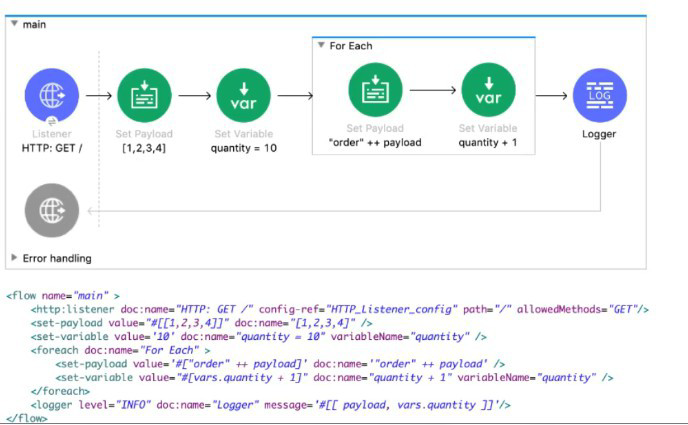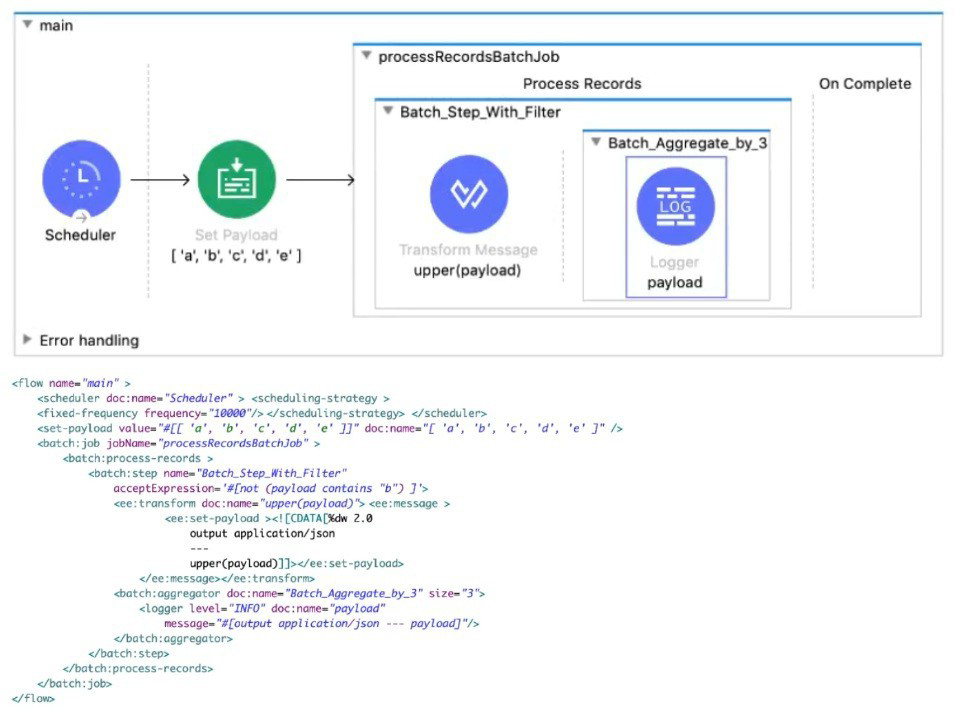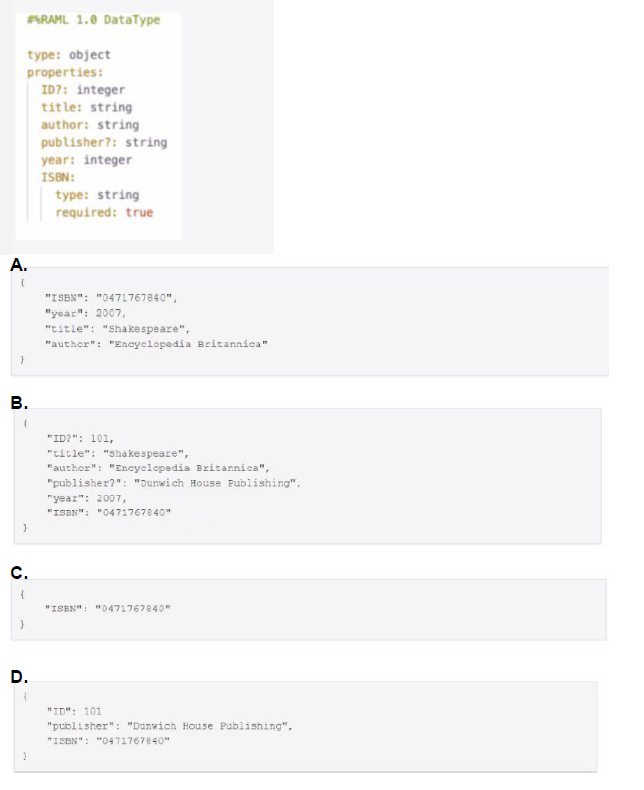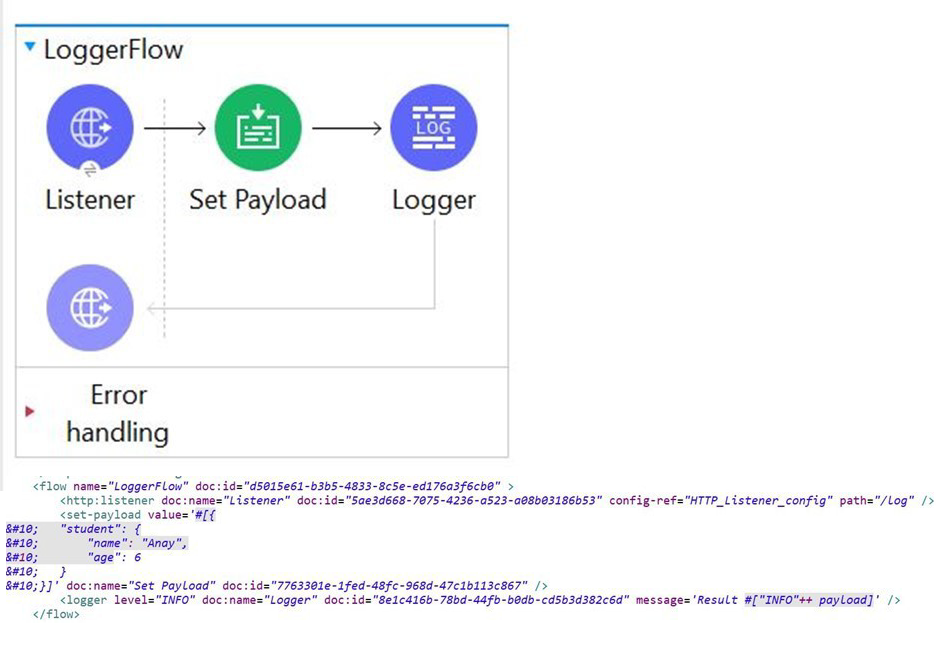How does APIkit determine the number of flows to generate from a RAML specification?
A. How does APIkit determine the number of flows to generate from a RAML specification?
B. Creates a separate flow for each HTTP method
C. Creates a separate flow for each response status code
D. Creates a separate flow for each resource that contains child resources
According to Mulesoft, how are Modern APIs treated as?
A. Products
B. SOAP API's
C. Rest API's
D. Code
Explanation:
Correct answer is Products
Modern API has three features 1) Treated as products for easy consumption 2) Discoverable and accessible through self-service 3) Easily managed for security , scalability and performance
Refer to the exhibits.

What payload and quantity are togged at the end of the main flow?
A. [[order1, order2, order3, order4], 14]
B. [[1,2,3,4], 10]
C. [[1,2,3,4], 14]
D. [orderlorder2order3order4, 14]
An organization's Center for enablement (C4E)has built foundational assets (API specifications and implementation templates, common frameworks, and best practices guides) and published them to Anypoint Exchange.
What is a metric related to these foundational assets that helps the organization measure the success of it's C4E efforts?
A. Utilization counts of foundational assets in production applications
B. Correlation of each foundational asset with the counts of developers that download such asset
C. Correlation of key performance indicators (KPI) of production applications with foundational assets
D. Count how many Lines Of Business (LoBs) onsumed each foundational asset
Explanation:
Below are the Key performance indicators (KPIs), to measure and track the and success ofthe C4E and its activities, as well as the growth and health of the application network. Most of the metrics can be extracted automatically, through REST APIs, from Anypoint Platform.
• # of assets published to Anypoint Exchange
• # of interactions with Anypoint Exchange assets
• # of APIs managed by Anypoint Platform
• # of System APIs managed by Anypoint Platform
• # of API clients registered for access to APIs
• # of API implementations deployed to Anypoint Platform
• # of API invocations
• # or fraction of lines of code covered by automated tests in CI/CD pipeline
• Ratio of info/warning/critical alerts to number of API invocations
Refer to the exhibits. APIKit router is used to generate the flow components for RAML pecification.
The Mule application must be available to REST clients using the two URL's
http://localhost:8081/internal and http://localhost:8081/external
How many APIKit Router components are generated to handle requests to every endpoint defined in RAML specification?
1. Library.raml
2./books
3. get:
4. post:
5./order:
6. get
7. patch 8./members
9. get:
A. 1
B. 2
C. 3
D. 5
What is minimal requirement in a flow for a Mule application to compile?
A. Event Source
B. Event Processors
C. Error handlers
D. Source and processors both
Explanation: Process section is must to get compiles. Process section must have one or more processors
Refer to the exhibits.
 The input array of strings is processed by the batch job that processes, filters, and aggregates the values. What is the last message logged by the Logger component after the batch job completes processing?
The input array of strings is processed by the batch job that processes, filters, and aggregates the values. What is the last message logged by the Logger component after the batch job completes processing?
A. [ ["A", "C", "D" ], ["E"] ]
B. [''E'']
C. [''D", "E"]
D. [ "A", "C, "D", "E" ]
Explanation:
Logs would look like:
INFO 2021-06-09 19:14:56,039 [[MuleRuntime].uber.06: [validationtest].batch-job- validationtestBatch_Job-work-manager @6de10f3e] [processor:
validationtestFlow/processors/1/route/0/route/0/aggregator/processors/0; event: bfb751e1- 9939-11eb-9f69-02053763653a]
org.mule.runtime.core.internal.processor.LoggerMessageProcessor: [
“\”A\””,
“\”C\””,
“\”D\””
]
—-
INFO 2021-06-09 19:15:02,486 [[MuleRuntime].uber.06: [validationtest].batch-job-validationtestBatch_Job-work-manager @6de10f3e] [processor:
validationtestFlow/processors/1/route/0/route/0/aggregator/processors/0; event: bfb751e1- 9939-11eb-9f69-02053763653a]
org.mule.runtime.core.internal.processor.LoggerMessageProcessor: [ “\”E\””
]
Batch aggregator value is 3. Hence in first time it will print [“A”, “C”, “D”] and in next iteration it will print [ “E” ]
--------------------------------------------------------------------------------------------------------------------
Correct answer is [ “E” ]
A Utlility.dwl is located in a Mule project at src/main/resources/modules. The Utility.dwl file defines a function named encryptString that encrypts a String What is the correct DataWeave to call the encryptString function in a Transform Message component?
A. 1. %dw 2.0
2. output application/json
3. import modules::Utility
4. ---
5. Utility::encryptString( "John Smith" )
B. 1. %dw 2.0
2. output application/json
3. import modules::Utility
4. ---
5. encryptString( "John Smith" )
C. 1. %dw 2.0
2. output application/json
3. import modules.Utility
4. ---
5. encryptString( "John Smith" )
D. 1. %dw 2.0
2. output application/json
3. import modules.Utility
4. ---
Utility.encryptString( "John Smith" )
Explanation:
Correct answer is %dw 2.0 output application/json import modules::Utility
---
Utility::encryptString( "John Smith" )
DataWeave 2.0 functions are packaged in modules. Before you begin, note that DataWeave 2.0 is for Mule 4 apps. For Mule 3 apps, refer to DataWeave Operators in the Mule 3.9 documentation. For other Mule versions, you can use the version selector for the Mule Runtime table of contents.
Functions in the Core (dw::Core) module are imported automatically into your DataWeave scripts. To use other modules, you need to import the module or functions you want to use by adding the import directive to the head of your DataWeave script, for example:
import dw::core::Strings
import camelize, capitalize from dw::core::Strings import * from dw::core::Strings
The way you import a module impacts the way you need to call its functions from a DataWeave script. If the directive does not list specific functions to import or use * from to import all functions from a function module, you need to specify the module when you call the function from your script. For example, this import directive does not identify any functions to import from the String module, so it calls the pluralize function like this: Strings::pluralize("box").
Transform
%dw 2.0
import dw::core::Strings output application/json
---
{ 'plural': Strings::pluralize("box") }
Refer to the exhibit. This RAML fragment defines a Book data type that is used in a RAML API specification.
An API implementation is created for this RAML API specification.
What is valid JSON input for a request from a web client to an implementation of this RAML API specification?

A. Option A
B. Option B
C. Option C
D. Option D
Refer to the payload.

The Set payload transformer sets the payload to an object. The logger component's message attribute is configured with the string "Result #["INFO"++ payload]"
What is the output of logger when this flow executes?
A. Result INFOpayload
B. Result INFO{"student":{"name":"Anay","age":6}}
C. 1. 1. "You called the function '++' with these arguments:
D. 2. 1: String ("INFO")
E. 3: Object ({student: {name: "Anay" as String {class: "java.lang.String"},age: 6 as Numbe...)
F. Error : You evaluated inline expression # without ++
Explanation:
Correct answer is as below as concatenation operation works only with string and not with the objects. In this case payload is object.
"You called the function '++' with these arguments:
1: String ("INFO")
2: Object ({student: {name: "Anay" as String {class: "java.lang.String"},age
| Page 10 out of 24 Pages |
| Salesforce-MuleSoft-Developer-I Practice Test Home | Previous |